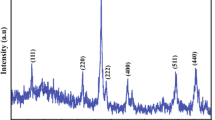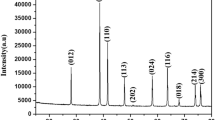Abstract
In this paper we report the effect of divalent cobalt on the structural and magnetic properties of substituted magnetites, Fe 3−x Co x O 4, with γ=Co 2+/Fe = 0, 5, 10, 15, 20 and 30 % wt, synthesized by the coprecipitation method. The samples were characterized by Atomic Absorption Spectroscopy, X-ray Diffraction, room temperature Mössbauer Spectroscopy and Vibrating Sample Magnetometry. The effect of Co 2+ was found to depend strongly of the concentration employed in the synthesis process. For γ≤15 % the Co 2+ promotes the formation of particles more crystalline and with higher saturation magnetization, remanence and coercivity than those obtained in absence of this cation. A sequential increasing of the lattice parameter is observed, as well as a reduction in the hyperfine magnetic field of the Fe 2.5+sub spectrum, while the hyperfine magnetic field of the Fe 3+sub spectrum keeps almost constant. For γ=20 % and 30 % the crystallinity of the samples decreases, particle size distribution effects are evidenced and the saturation magnetization decreases drastically. The results suggest that for low Co 2+ contents the substitution of Fe 3+by Co 2+ at octahedral sites of the inverse spinel system is the dominant effect, while for the highest concentrations used the substitution of Fe 2+ by Co 2+ and the increasing of the particle size distribution are the dominant effects.
Similar content being viewed by others
References
Chen, I.-H., Wang, C.-C., Chen, C.-Y.: Fabrication and characterization of magnetic cobalt ferrite/polyacrylonitrile and cobalt ferrite/carbon nanofibers by electrospinning. Carbon 48, 604–611 (2010)
Hua, J., Liu, M., Wang, L., Xu, S.C., Feng, M., Li, H.B.: Effect of Co 2+ content on the magnetic properties of Co xFe 3−x O 4/SiO 2 nanocomposites. Hyperfine Interact 219, 41–48 (2013)
Bogush, B.: Application of electroless metal deposition for advanced composite shielding materials. J. Optoelectron. Adv. Mater. 7(3), 1635–1642 (2005)
Moon, S.K., Jae, G.K.: Microwave-Absorbing Characteristics of NiCoZn Ferrite Prepared by Using a Co-Precipitation Method. Journal of the Korean Physical Society 53(2), 737–741 (2008)
Praveena, K., Srinath, S.: Synthesis and Characterization of CoFe2O4/Polyaniline Nanocomposites for Electromagnetic Interference Applications. J. Nanosci. Nanotechnol. 14, 4371–4376 (2014)
Kumbhar, V.S., Jagadale, A.D., Shinde, N.M., Lokhande, C.D.: Chemical synthesis of spinel cobalt ferrite (CoFe 2 O 4) nano-flakes for supercapacitor application. Appl. Surf. Sci. 259, 39–43 (2012)
The International Magnetics Association: Soft Ferrite Cores, A User’s Guide. http://www.transformer-assn.org/Soft%20Ferrite%20Cores%20User%20Guide.pdf. Accessed 15 June 2014
Felderhof, B.U.: Flow of a ferrofluid down a tube in an oscillating magnetic field. Phys. Review E 64, 021508–1/021508-7 (2001)
Bilecka, I., Kubli, M., Amstad, E., Niederberger, M.: Simultaneous formation of ferrite nanocrystals and deposition of thin films via a microwave-assisted nonaqueous sol–gel process. J. Sol.-Gel. Sci. Technol. 57, 313–322 (2011)
Pankhurst, Q.A., Connolly, J., Jones, S.K., Dobson, J.: Application of magnetic nanoparticles in biomedicine. J. Phys. D: Appl. Phys. 36, R167–R181 (2003)
Cornell, R.M., Schwertmann, U.: The iron oxides, pp. 135, 140. WILEY-VCH Verlag GmbH, D-69469 Weinheim, Germany (2000)
Skoog, D.A., West, D.M., Holler, F.J, Crouch, S.R.: Fundamentals of Analytical Chemistry, Ninth Edition. Brooks/Cole, Cengage Learning, pp. 289 (2013)
Dong, C.: PowderX: Windows-95-based program for powder X-ray diffraction data processing. J Appl Crystallogr 32, 168–173 (1999)
Zhang, H.G., Zhang, Y.J., Wang, W.H., Wu, G.H.: Origin of the constricted hysteresis loop in cobalt ferrites revisited. J. Magn. Magn. Mater. 323, 1980–1984 (2011)
Monshi, A., Reza Foroughi, M., Reza Monshi, M.: Modified Scherrer Equation to Estimate More Accurately Nano-Crystallite Size Using XRD. World Journal of Nano Science and Engineering 2, 154–160 (2012)
Vandenberghe, R., De Grave, E., De Bakker, P.M.A.: On the methodology of the analysis of Mössbauer spectra. Hyperfine Interact 83, 29–49 (1994)
Willard, M.A., Nakamura, Y., Laughlin, D.E., McHenry, M.E.: Magnetic Properties of Ordered and Disordered Spinel-Phase Ferrimagnets. J. Am. Ceram. Soc. 82 [12], 3342–3346 (1999)
Sorescu, M., Oberst, T., Gosset, K., Tarabasanu, D., Diamandescu, L.: Direct Evidence for Cobalt Substitution Effects in Magnetite. Solid State Commun. 113 (10), 573–575 (2000)
da Costa, G.M., Andujar, C.B., De Grave, E., Pankhurst, Q.: Magnetite, non-stoichiometric magnetite and maghemite: Can they be distinguished by Mössbauer spectroscopy?. ICAME 2013 - International Conference on the Applications of the Mössbauer Effect, Opatija, Croatia, 1-6 September 2013. http://www.icame2013opatija.com/system/file/249/da_Costa_P2.pdf. Accessed 15 December 2014
Author information
Authors and Affiliations
Corresponding author
Additional information
Proceedings of the 14th Latin American Conference on the Applications of the Mössbauer Effect (LACAME 2014), Toluca, Mexico, 10-14 November 2014
Rights and permissions
About this article
Cite this article
Velásquez, A.A., Urquijo, J.P. Influence of Co2+ on the structural and magnetic properties of substituted magnetites obtained by the coprecipitation method. Hyperfine Interact 232, 97–110 (2015). https://doi.org/10.1007/s10751-015-1122-3
Published:
Issue Date:
DOI: https://doi.org/10.1007/s10751-015-1122-3




